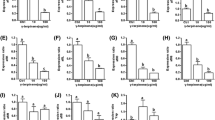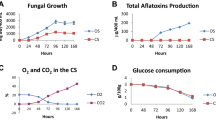Abstract
A close correlation between lipoperoxide formation in cells ofAspergillus parasiticus and aflatoxin biosynthesis has been established in rich and poor media in which oxidative stress was induced by addition of cumene hydroperoxide, a lipoperoxidation inducer. The presence of hydroperoxides of linoleic acid inA. parasiticus mycelia was analysed by liquid chromatography-mass spectrometry (LC-MS). This relation appears to be driven by activation of certain oxidative stress related transcription factors, such asyap1-like,skn7-like andhsf2-like. Activation of these factors then leads to the promotion of transcription of genes encoding antioxidant-related enzymes, such as superoxide dismutase, catalase and glutathione peroxidase.
The incomplete seavenging of intracellular oxidation inA. parasiticus cells can lead to aflatoxin biosynthesis. The relationship between oxidative stress and aflatoxin biosynthesis is indicated by the high correlation among increased activity of lipoperoxidation and the antioxidant defence system with formation of aflatoxins.
With regard to the relationship of oxidative stress and aflatoxin biosynthesis, the mechanism of action of butylated hydroxyl anisole (BHA), an antioxidant compound, in the control of aflatoxin biosynthesis was also investigated. Results indicate this compound can act,per se, by inhibiting lipoperoxidation and by inducing antioxidative defence responses of the fungal cell.
Similar content being viewed by others
References
Fabbri AA, Fanelli C, Panfili G, Passi S, Fasella P (1983) Lipoperoxidation and aflatoxin biosynthesis byAspergillus parasiticus andA. flavus. J Gen Microbiol 129: 3447–3452
Fanelli C, Fabbri AA, Finotti E, Fasella P, Passi S (1984) Free radicals and aflatoxin biosynthesis. Experientia 40: 191–193
Passi S, Fanelli C, Fabbri AA, Finotti E, Panfili G, Nazzarro-Porro M (1985) Effect of halomethanes on aflatoxin induction in cultures ofAspergillus parasiticus. J Gen Microbiol 131: 687–691
Fanelli C, Fabbri AA, Pieretti S, Finotti E, Passi S (1985) Effect of different antioxidants and free radical scavengers on aflatoxin production. Mycol Res 1: 65–69
Fanelli C, Fabbri AA (1989) Relationship between lipids and aflatoxin biosynthesis. Mycopathologia 107: 115–120
Tsitsigiannis D, Wilson RA, Keller NP (2001) Lipid mediated signalling in theAspergillus seed interaction. Proceeding of the 10th International Congress on Molecular Plant Microbe Interaction. Biology and Plant Microbe Interaction 3: 186–191
Burow GB, Nesbitt TC, Dunlap J, Keller NP (1997) Seed lipoxygenase products modulateAspergillus mycotoxin biosynthesis. Mol Plant Microbe Interract 10(3): 380–387
Wilson RA, Gardner HW, Keller NP (2001) Cultivar-dependent expression of a maize lipoxygenase responsive to seed infesting fungi. Mol Plant-Microbe Interact 14 (8): 980–987
Jayashree T, Subramanyam C (2000) Oxidative stress as a prerequisite for aflatoxin production byAspergillus parasiticus. Free Rad Biol Med 29: 981–985
Pryce MS, Conners SB, Tachdjian S, Kelly RM, Payne G (2005) Aflatoxin conductive and non-conductive growth conditions reveal new gene associations with aflatoxin production. Fungal Genet Biol 42: 506–518
Kim JH, Campbell BC, Yu J, Mahoney N, Chan KL, Molyneux RJ, Bhatnagar D, Cleveland TE (2004) Examination of fungal stress response genes usingSaccharomyces cerevisiae as a model system: targeting genes affecting aflatoxin biosynthesis byAspergillus flavus Link. Appl. Microb Biotechnol 67 (6): 807–815
Fanelli C, Tasca V, Ricelli A, Reverberi M, Zjalic S, Finotti E, Fabbri AA (2000) Inhibiting effect of medicinal mushroomLentinus edodes (Berk.) Sing (Agaricomycetdeae) on aflatoxin production byAspergillus parasiticus Speare. Int J. Med Mush 2: 229–236
Ricelli A, Fabbri AA, Trionfetti-Nisini, P., Reverberi M, Zjalie S, Fanelli C (2002) Inhibiting effect of different edible and medicinal mushrooms on the growth of two ochratoxigenic microfungi. Int J Med Mush 4 (2): 173
Reverberi M, Fabbri AA, Zjalic S, Ricelli A, Punelli F, Fanelli C (2005) Antioxidant enzymes stimulation inAspergillus parasiticus byLentinula edodes inhibits aflatoxin production. Appl Microbiol Biotechnol 69: 207–215
Reverberi M, Fanelli C, Zjalic S, Briganti S, Picardo M, Ricelli A, Fabbri AA (2005) Relationship among lipoperoxides, jasmonates and indole-3-acetic acid formation in potato tuber after wounding. Free Radical Research 39 (6): 637–647
Nguyen T, Sherratt PJ, Pickett CB (2003) Regulatory mechanisms controlling gene expression mediated by the antioxidant response element. Annu Rev Pharmacol Toxicol 43: 233–260
Moye-Rowley WS (2003) Regulation of transcriptional response top oxidative stress in fungi: similarities and differences. Eukaryotic Cell 2: 381–389
Estruch F (2000) Stress-controlled transcription factors, stress-induced genes and stress tolerance in budding yeast. FEMS Microb Rev 24: 469–486
Author information
Authors and Affiliations
Corresponding author
Rights and permissions
About this article
Cite this article
Reverberi, M., Zjalic, S., Ricelli, A. et al. Oxidant/antioxidant balance inAspergillus parasiticus affects aflatoxin biosynthesis. Mycotox Res 22, 39–47 (2006). https://doi.org/10.1007/BF02954556
Issue Date:
DOI: https://doi.org/10.1007/BF02954556




